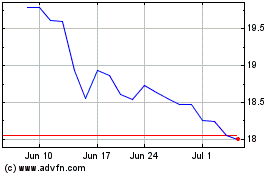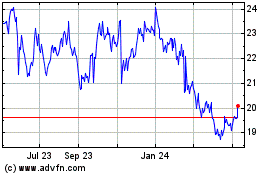By Heather Haddon and Julie Jargon
The U.S. is on track this year to post the longest stretch of
falling food prices in more than 50 years, a streak that is
cheering U.S. shoppers at the checkout line but putting a financial
strain on farmers, grocery stores and restaurants.
The trend is being fueled by an excess supply of dairy products,
meat, grains and other staples and less demand for many of those
same products from China and elsewhere due to the strong dollar.
Lower energy costs for transportation and refrigeration also are
contributing to sagging food prices, say economists.
"Deflation is a godsend for consumers," said Bob Goldin, vice
chairman of food consultancy Technomic Inc.
Nationwide, the price of a gallon of whole milk on average was
off 11% to $3.06 in July over a year ago; the price of a dozen
large eggs fell 40% to $1.55 in the same period.
Those great bargains at the grocery store are spreading pain
across the Farm Belt. Farmers and ranchers are getting less money
for raw milk, cheese and cattle, forcing them to slash spending.
Tractor suppliers like Deere & Co. are cutting production due
to the farming slump.
Economists and food analysts say the supermarket price declines
could last at least through year-end. The drop comes as weaker
demand from China is broadly resetting commodities prices in
everything from cheese to iron ore. The current food-price slump
soon could beat the nine months of year-to-year declines
experienced in 2009 and 2010 -- the longest stretch since 1960,
according to the Bureau of Labor Statistics.
The price of food at home is down 1.6% on a seasonally
unadjusted basis in the 12 months ended in July, according to the
BLS.
Stephanie Hegre, a 46-year-old nanny in Thousand Oaks, Calif.,
has noticed an about 10% drop in her weekly food shopping bill. Her
16-year-old twin daughters go through a lot of milk, meat and
bread, adding up to an average weekly grocery bill of about
$200.
"I feel it has dropped by $20 a week which, when you're on a
budget, is noticeable," said Ms. Hegre, who has been stockpiling
staples in case prices increase. "We freeze bread and buy two
weeks' worth of bacon at a time," she said.
The glut is so severe in some places that dairy farmers have
been dumping millions of pounds of excess milk onto fields. The
U.S. Department of Agriculture just bought $20 million worth of
cheese in response to hard-hit dairy farmers' requests. The cheese
was given to food banks and others through USDA
nutrition-assistance programs.
Ben Moore, a sixth-generation farmer who grows corn and soybeans
on some 5,000 acres in Indiana and Ohio, said 2016 is shaping up to
be his least profitable year in 20 years. Facing weak crop prices,
he is making do with his current tractors and combines rather than
upgrading his equipment, and is pushing for lower prices on
pesticides, seeds and fertilizer.
On Friday, corn futures, which peaked in 2012 at more than $8 a
bushel, closed at $3.16 a bushel, a seven-year low, on the Chicago
Board of Trade.
"We cannot withstand $4 a bushel corn," Mr. Moore said.
Farmers who had built a nest egg after a robust period earlier
this decade now have exhausted those reserves, said Karl Setzer, a
market analyst for MaxYield Cooperative, a West Bend, Iowa, grain
marketer. "The guys that are heavily leveraged and those who don't
have a plan of action will suffer for a while."
Falling costs are taking a toll on many food retailers. Grocery
stores already have thin profit margins and deflation tends to
reduce the value of their inventory. To stay competitive, they must
cut prices on existing goods before lower-priced stables land on
the loading dock, and have fewer opportunities to raise prices.
At least six national food retailers, including Costco Wholesale
Corp. and Whole Foods Market Inc., and four of the five largest
publicly traded food distributors, including Sysco Corp. and US
Foods Holding Corp., have reported that their margins suffered in
the last quarter because of food deflation, the first time analysts
can recall so many grocers singling out deflation as a big
problem.
"Deflation is kind of the elephant in the room," Dennis Eidson,
chief executive of SpartanNash Co., which operates 160 grocery
stores from Colorado to Ohio and distributes food to 1,900
retailers across the country, told investors this month.
Grocers such as Supervalu Inc. and Smart & Final Stores Inc.
have been hit particularly hard. Even when the volume of products
increased, profits have decreased in some categories because the
price declines were so steep. Smart & Final's division catering
to restaurants sold 42% more packages of eggs during its most
recent quarter but recorded a 34% drop in egg revenue because of
the lower prices, Chief Executive David Hirz told investors.
Not all food has gotten cheaper. Total fruits and vegetables
prices were up 1.4% in July from a year earlier in part due to the
drought in California.
Wal-Mart Stores Inc., the nation's largest food retailer, has
been one of the few to benefit from the falling prices, partly
because it attracted more customers after slashing prices earlier
this year. It reported strong second-quarter results this month
despite "ongoing deflationary impacts in food."
Normally, falling food prices would be good for restaurants, but
with higher labor costs, they have had to raise menu prices,
resulting in lost business. The second quarter was the industry's
weakest since the first quarter of 2010.
Three restaurant types posted declining sales in the quarter --
fast casual, casual dining and family dining -- and sales growth in
every other restaurant category slowed except pizza, according to
equity researcher William Blair & Co.
It has gotten a lot cheaper "to get beef at your local butcher
and go home and grill," said Todd Penegor, chief executive of
burger chain Wendy's Co., which reported second-quarter sales below
expectations.
--Kelsey Gee and Jesse Newman contributed to this article.
(END) Dow Jones Newswires
August 29, 2016 13:28 ET (17:28 GMT)
Copyright (c) 2016 Dow Jones & Company, Inc.
SpartanNash (NASDAQ:SPTN)
Historical Stock Chart
From Mar 2024 to Apr 2024

SpartanNash (NASDAQ:SPTN)
Historical Stock Chart
From Apr 2023 to Apr 2024
